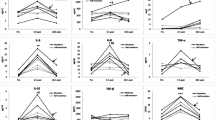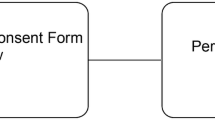Abstract
It has been suggested that exercise intensity is of importance in the regulation of increase in pro-inflammatory molecules, but there is still a debate about the effect of duration on these molecules. Therefore, the effect of exercise duration on the serum concentrations of interleukin-6 (IL-6), tumour necrosis factor-α (TNF-α), soluble form of intercellular adhesion molecule-1 (sICAM-1), and matrix metalloproteinase-9 (MMP-9) was studied in 22 half-marathon (HM) and 18 marathon (M) male amateur runners who completed their exercise task in 1.8 ± 0.2 (mean ± standard deviation) and 3.6 ± 0.4 h, respectively (thus, average speed was 11.7 ± 1.5 and 11.9 ± 1.8 km h−1, respectively). Blood was sampled 2 days before, 15 min after, and 28 h after the race. IL-6, TNF-α, and MMP-9 always increased immediately after exercise, but the increase was larger (P < 0.05) in M versus HM (∆IL-6: 31 ± 24 vs. 5 ± 4 pg ml−1; ∆TNF-α: 1.7 ± 1.9 vs. 0.5 ± 0.8 pg ml−1; MMP-9: 288 ± 216 vs. 145 ± 128 ng ml−1, respectively). sICAM-1 also increased with exercise, but similarly in M and HM (20 ± 40 vs. 23 ± 32 ng ml−1, respectively). Only sICAM-1 remained elevated 28 h post-exercise in both HM and M, while IL-6, TNF-α, and MMP-9 returned to pre-exercise levels. Competitive HM and M races induce significant increases in IL-6, TNF-α, sICAM-1, and MMP-9 concentrations. As HM and M runners performed the competition with similar absolute intensity, the difference in response between the groups suggests that exercise duration is of importance in the regulation of IL-6, TNF-α, and MMP-9, but not sICAM-1 concentrations in response to prolonged running.

Similar content being viewed by others
References
Akimoto T, Furudate M, Saitoh M, Sugiura K, Waku T, Akama T, Kono I (2002) Increased plasma concentrations of intercellular adhesion molecule-1 after strenuous exercise associated with muscle damage. Eur J Appl Physiol 86:185–190
Bernecker C, Scherr J, Schinner S, Braun S, Scherbaum WA, Halle M (2011) Evidence for an exercise induced increase of TNF-alpha and IL-6 in marathon runners. Scand J Med Sci Sports. doi:10.1111/j.1600-0838.2011.01372.x
Bruunsgaard H, Galbo H, Halkjaer-Kristensen J, Johansen TL, MacLean DA, Pedersen BK (1997) Exercise-induced increase in serum interleukin-6 in humans is related to muscle damage. J Physiol 499(Pt 3):833–841
Chaar V, Romana M, Tripette J, Broquere C, Huisse MG, Hue O, Hardy-Dessources MD, Connes P (2011) Effect of strenuous physical exercise on circulating cell-derived microparticles. Clin Hemorheol Microcirc 47:15–25
Chakrabarti S, Zee JM, Patel KD (2006) Regulation of matrix metalloproteinase-9 (MMP-9) in TNF-stimulated neutrophils: novel pathways for tertiary granule release. J Leukoc Biol 79:214–222
Chan MH, Carey AL, Watt MJ, Febbraio MA (2004) Cytokine gene expression in human skeletal muscle during concentric contraction: evidence that IL-8, like IL-6, is influenced by glycogen availability. Am J Physiol Regul Integr Comp Physiol 287:R322–R327
Chen Y, Fan Y, Poon KY, Achrol AS, Lawton MT, Zhu Y, McCulloch CE, Hashimoto T, Lee C, Barbaro NM, Bollen AW, Yang GY, Young WL (2006) MMP-9 expression is associated with leukocytic but not endothelial markers in brain arteriovenous malformations. Front Biosci 11:3121–3128
Danzig V, Mikova B, Kuchynka P, Benakova H, Zima T, Kittnar O, Skrha J, Linhart A, Kalousova M (2010) Levels of circulating biomarkers at rest and after exercise in coronary artery disease patients. Physiol Res 59:385–392
Dasu MR, Barrow RE, Spies M, Herndon DN (2003) Matrix metalloproteinase expression in cytokine stimulated human dermal fibroblasts. Burns 29:527–531
Dill DB, Costill DL (1974) Calculation of percentage changes in volumes of blood, plasma, and red cells in dehydration. J Appl Physiol 37:247–248
Duclos M, Corcuff JB, Rashedi M, Fougere V, Manier G (1997) Trained versus untrained men: different immediate post-exercise responses of pituitary adrenal axis. A preliminary study. Eur J Appl Physiol Occup Physiol 75:343–350
Gokhale R, Chandrashekara S, Vasanthakumar KC (2007) Cytokine response to strenuous exercise in athletes and non-athletes—an adaptive response. Cytokine 40:123–127
Helge JW, Stallknecht B, Pedersen BK, Galbo H, Kiens B, Richter EA (2003) The effect of graded exercise on IL-6 release and glucose uptake in human skeletal muscle. J Physiol 546:299–305
Jammes Y, Steinberg JG, Delliaux S, Bregeon F (2009) Chronic fatigue syndrome combines increased exercise-induced oxidative stress and reduced cytokine and Hsp responses. J Intern Med 266:196–206
Kern PA (1997) Potential role of TNFalpha and lipoprotein lipase as candidate genes for obesity. J Nutr 127:1917S–1922S
Kim HJ, Lee YH, Kim CK (2007) Biomarkers of muscle and cartilage damage and inflammation during a 200 km run. Eur J Appl Physiol 99:443–447
Kimura H, Suzui M, Nagao F, Matsumoto K (2001) Highly sensitive determination of plasma cytokines by time-resolved fluoroimmunoassay; effect of bicycle exercise on plasma level of interleukin-1 alpha (IL-1 alpha), tumor necrosis factor alpha (TNF alpha), and interferon gamma (IFN gamma). Anal Sci 17:593–597
Koskinen SO, Heinemeier KM, Olesen JL, Langberg H, Kjaer M (2004) Physical exercise can influence local levels of matrix metalloproteinases and their inhibitors in tendon-related connective tissue. J Appl Physiol 96:861–864
MacDonald C, Wojtaszewski JF, Pedersen BK, Kiens B, Richter EA (2003) Interleukin-6 release from human skeletal muscle during exercise: relation to AMPK activity. J Appl Physiol 95:2273–2277
Madden MC, Byrnes WC, Lebin JA, Batliner ME, Allen DL (2011) Plasma matrix metalloproteinase-9 response to eccentric exercise of the elbow flexors. Eur J Appl Physiol 111(8):1795–1805
Monchanin G, Serpero LD, Connes P, Tripette J, Wouassi D, Bezin L, Francina A, Ngongang J, de la Pena M, Massarelli R, Gozal D, Thiriet P, Martin C (2007) Effects of progressive and maximal exercise on plasma levels of adhesion molecules in athletes with sickle cell trait with or without alpha-thalassemia. J Appl Physiol 102:169–173
Monchanin G, Serpero LD, Connes P, Tripette J, Wouassi D, Francina A, Massarelli R, Gozal D, Thiriet P, Martin C (2008) Plasma levels of adhesion molecules ICAM-1 and VCAM-1 in athletes with sickle cell trait with or without alpha-thalassemia during endurance exercise and recovery. Clin Hemorheol Microcirc 40:89–97
Nielsen HG, Lyberg T (2004) Long-distance running modulates the expression of leucocyte and endothelial adhesion molecules. Scand J Immunol 60:356–362
Nieman DC (2007) Marathon training and immune function. Sports Med 37:412–415
Nieman DC, Davis JM, Henson DA, Walberg-Rankin J, Shute M, Dumke CL, Utter AC, Vinci DM, Carson JA, Brown A, Lee WJ, McAnulty SR, McAnulty LS (2003) Carbohydrate ingestion influences skeletal muscle cytokine mRNA and plasma cytokine levels after a 3-h run. J Appl Physiol 94:1917–1925
Nieman DC, Davis JM, Henson DA, Gross SJ, Dumke CL, Utter AC, Vinci DM, Carson JA, Brown A, McAnulty SR, McAnulty LS, Triplett NT (2005) Muscle cytokine mRNA changes after 2.5 h of cycling: influence of carbohydrate. Med Sci Sports Exerc 37:1283–1290
Nieman D, Henson D, Gojanovich G, Davis JM, Dumke C, Utter A, Murphy A, Pearce S, McAnulty S, McAnulty L (2007) Immune changes: 2 h of continuous vs. intermittent cycling. Int J Sports Med 28:625–630
Ostrowski K, Schjerling P, Pedersen BK (2000) Physical activity and plasma interleukin-6 in humans—effect of intensity of exercise. Eur J Appl Physiol 83:512–515
Peake JM, Suzuki K, Hordern M, Wilson G, Nosaka K, Coombes JS (2005) Plasma cytokine changes in relation to exercise intensity and muscle damage. Eur J Appl Physiol 95:514–521
Pedersen BK (2009) Edward F. Adolph Distinguished Lecture: muscle as an endocrine organ: IL-6 and other myokines. J Appl Physiol 107:1006–1014
Petersen AM, Pedersen BK (2005) The anti-inflammatory effect of exercise. J Appl Physiol 98:1154–1162
Rullman E, Rundqvist H, Wagsater D, Fischer H, Eriksson P, Sundberg CJ, Jansson E, Gustafsson T (2007) A single bout of exercise activates matrix metalloproteinase in human skeletal muscle. J Appl Physiol 102:2346–2351
Saenz AJ, Lee-Lewandrowski E, Wood MJ, Neilan TG, Siegel AJ, Januzzi JL, Lewandrowski KB (2006) Measurement of a plasma stroke biomarker panel and cardiac troponin T in marathon runners before and after the 2005 Boston marathon. Am J Clin Pathol 126:185–189
Scherr J, Braun S, Schuster T, Hartmann C, Moehlenkamp S, Wolfarth B, Pressler A, Halle M (2011) 72-h kinetics of high-sensitive troponin T and inflammatory markers after marathon. Med Sci Sports Exerc 43:1819–1827
Shinkai S, Watanabe S, Asai H, Shek PN (1996) Cortisol response to exercise and post-exercise suppression of blood lymphocyte subset counts. Int J Sports Med 17:597–603
Srivastava AK, Qin X, Wedhas N, Arnush M, Linkhart TA, Chadwick RB, Kumar A (2007) Tumor necrosis factor-alpha augments matrix metalloproteinase-9 production in skeletal muscle cells through the activation of transforming growth factor-beta-activated kinase 1 (TAK1)-dependent signaling pathway. J Biol Chem 282:35113–35124
Starkie RL, Rolland J, Angus DJ, Anderson MJ, Febbraio MA (2001) Circulating monocytes are not the source of elevations in plasma IL-6 and TNF-alpha levels after prolonged running. Am J Physiol Cell Physiol 280:C769–C774
Steensberg A, Keller C, Starkie RL, Osada T, Febbraio MA, Pedersen BK (2002) IL-6 and TNF-alpha expression in, and release from, contracting human skeletal muscle. Am J Physiol Endocrinol Metab 283:E1272–E1278
Suzuki K, Nakaji S, Yamada M, Liu Q, Kurakake S, Okamura N, Kumae T, Umeda T, Sugawara K (2003) Impact of a competitive marathon race on systemic cytokine and neutrophil responses. Med Sci Sports Exerc 35:348–355
Tayebjee MH, Lip GY, Blann AD, Macfadyen RJ (2005) Effects of age, gender, ethnicity, diurnal variation and exercise on circulating levels of matrix metalloproteinases (MMP)-2 and -9, and their inhibitors, tissue inhibitors of matrix metalloproteinases (TIMP)-1 and -2. Thromb Res 115:205–210
Tomaszewski M, Charchar FJ, Przybycin M, Crawford L, Wallace AM, Gosek K, Lowe GD, Zukowska-Szczechowska E, Grzeszczak W, Sattar N, Dominiczak AF (2003) Strikingly low circulating CRP concentrations in ultramarathon runners independent of markers of adiposity: how low can you go? Arterioscler Thromb Vasc Biol 23:1640–1644
Wallberg L, Mikael MC, Enqvist JK, Ekblom B (2011) Plasma IL-6 concentration during ultra-endurance exercise. Eur J Appl Physiol 111:1081–1088
Acknowledgments
This work has been supported by the European Social Fund within the project “Support for Doctoral Studies at University of Latvia”. This study was supported in part by Grant No. 2010.10-4/VPP-4/5 of the framework of the Latvian National Program.
Author information
Authors and Affiliations
Corresponding author
Additional information
Communicated by Fabio Fischetti.
Rights and permissions
About this article
Cite this article
Reihmane, D., Jurka, A., Tretjakovs, P. et al. Increase in IL-6, TNF-α, and MMP-9, but not sICAM-1, concentrations depends on exercise duration. Eur J Appl Physiol 113, 851–858 (2013). https://doi.org/10.1007/s00421-012-2491-9
Received:
Accepted:
Published:
Issue Date:
DOI: https://doi.org/10.1007/s00421-012-2491-9




